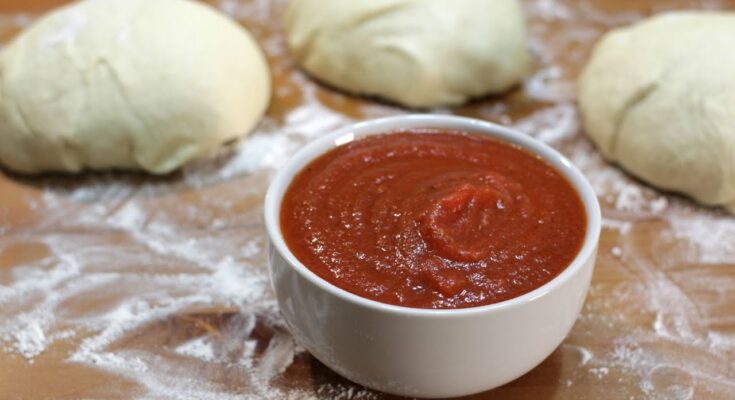Pizza Sauce Recipe: Creating your own pizza sauce at home can take your pizza-making game to the next level! With just a handful of fresh, flavorful ingredients, you can whip up a sauce that beats anything you’d find in a jar.
It’s easy, affordable, and lets you customize the flavor to your exact preference, making it ideal for anyone who loves the classic taste of Italian-style pizza.
Ingredients Needed for Pizza Sauce
The ingredients for a delicious pizza sauce are simple and straightforward, but each one plays a critical role in achieving that perfect balance of sweet, tangy, and savory flavors.
Basic Ingredients:
- Tomatoes (fresh or canned): These form the base of your sauce. Opt for ripe Roma or San Marzano tomatoes if using fresh, or go for high-quality canned crushed tomatoes for convenience.
- Garlic: Adds depth and a hint of sweetness.
- Olive Oil: Essential for a smooth and rich texture.
- Onion (optional): Provides a subtle sweetness when sautéed.
- Dried or Fresh Oregano: For classic Italian flavor.
- Dried Basil or Fresh Basil Leaves: Complements the oregano and enhances the aroma.
- Salt and Pepper: To season and balance flavors.
- Sugar (optional): A small pinch helps counteract acidity in tomatoes.
Step-by-Step Recipe Instructions
Step 1: Preparing the Ingredients
Start by gathering and prepping everything you’ll need. Having your ingredients measured out and ready will make the cooking process smoother.
- Tomatoes: If using fresh tomatoes, score an “X” on the bottom of each, blanch them in boiling water for 1-2 minutes, then transfer them to an ice bath. Peel the skin, remove seeds if desired, and chop the tomatoes roughly. For canned tomatoes, simply open the can and measure as needed.
- Garlic: Mince finely or crush with a garlic press to release its full aroma.
- Onion: Finely dice if using, as it will be sautéed to blend seamlessly into the sauce.
Step 2: Sautéing the Garlic and Onion
Aromatic ingredients like garlic and onion build the flavor base for your pizza sauce. Sautéing them releases their natural sweetness, enhancing the sauce without overwhelming it.
- Heat Olive Oil: In a medium-sized pan, heat about 2 tablespoons of olive oil over medium heat.
- Add Garlic and Onion: Add the minced garlic and diced onion to the hot oil. Stir constantly to prevent burning, cooking for 2-3 minutes until softened and fragrant.
Tip: Avoid high heat, as garlic can burn quickly and develop a bitter taste. Keep the heat moderate for best results.
Step 3: Adding Tomatoes and Cooking Down
With the aromatics ready, it’s time to bring in the tomatoes, which will be the star ingredient in the sauce.
- Add the Tomatoes: Pour in the chopped fresh tomatoes or crushed canned tomatoes.
- Cook Until Softened: Stir frequently, allowing the tomatoes to break down naturally over medium heat. This should take about 10-15 minutes.
- Consistency Check: If the sauce looks too chunky, gently mash the tomatoes with a spoon to help achieve a smoother texture.
Tip: For a thicker sauce, simmer longer until the liquid reduces to your desired consistency.
Step 4: Seasoning the Sauce
Seasoning the sauce at the right stage makes all the difference in the depth and quality of the final flavor.
- Add Herbs: Sprinkle in dried or fresh oregano, basil, and a pinch of salt and pepper. Adjust the amount based on your taste preference.
- Add Sugar (Optional): If the sauce tastes overly acidic, add a small pinch of sugar. Stir well to dissolve it completely.
- Adjust Seasonings: Taste the sauce as it cooks, adjusting the seasoning gradually until you’re satisfied with the balance of flavors.
Step 5: Simmering the Sauce
Simmering is where the magic happens. This process lets the flavors meld together, giving the sauce a deep and rich taste.
- Reduce Heat to Low: Once seasoned, lower the heat and let the sauce simmer gently.
- Simmer for 20-30 Minutes: Cover partially and let the sauce reduce, stirring occasionally to prevent sticking. The sauce should thicken as it cooks, developing a robust, complex flavor.
Step 6: Blending (Optional)
For a smoother sauce, you can blend it once simmering is complete. Blending can create a velvety texture that evenly coats your pizza crust.
- Use an Immersion Blender: If you have an immersion blender, blend directly in the pan until the sauce reaches your desired consistency.
- Transfer to a Blender: Alternatively, let the sauce cool slightly, then transfer to a blender and blend until smooth.
Note: Blending is optional. If you enjoy a chunky, rustic sauce, skip this step and keep the texture as is.
Step 7: Final Taste Test and Adjustments
After simmering and blending, the sauce should be rich and flavorful, but a final taste test is essential to ensure it’s just right.
- Taste the Sauce: Take a small spoonful to evaluate the balance of flavors.
- Adjust if Necessary: If the sauce needs more salt, sweetness, or herbs, add a little at a time until you reach your preferred taste.
Step 8: Cooling and Storing the Sauce
Allow the sauce to cool fully before storing to preserve its freshness and flavor.
- Cool Completely: Transfer the sauce to a container and let it reach room temperature.
- Store in an Airtight Container: Refrigerate for up to a week, or freeze in portions for up to 3 months.
Tips for Using Pizza Sauce on Pizza
- Spread Evenly: Use about 1/3 to 1/2 cup of sauce per 12-inch pizza, depending on how saucy you like it.
- Experiment with Toppings: A versatile pizza sauce pairs well with almost any topping, from classic mozzarella and pepperoni to fresh vegetables and herbs.
Alternative Pizza Sauce Ideas
If you’re feeling creative, try these unique variations:
- White Pizza Sauce: A creamy alternative made with garlic, butter, and Parmesan.
- Pesto Sauce: Basil pesto adds a fresh, herby twist to pizza.
Common Mistakes to Avoid
- Over-seasoning: Remember, it’s easier to add seasoning than to remove it.
- Overcooking: Excessive simmering can lead to a dry, overly concentrated sauce.
Health Benefits of Homemade Pizza Sauce
Making pizza sauce at home allows you to control the ingredients, avoiding unnecessary sugars and preservatives. Tomatoes are packed with lycopene, an antioxidant linked to heart health, and using fresh herbs enhances the nutritional profile with additional vitamins and minerals.
FAQs about Pizza Sauce Recipe
1. What Ingredients Are Commonly Used in Pizza Sauce?
Most pizza sauces start with a base of tomatoes—often canned, crushed, or pureed tomatoes. Essential ingredients include garlic, olive oil, salt, sugar, and a blend of Italian herbs like oregano, basil, and thyme. For a richer flavor, some recipes add onion powder, red pepper flakes, or grated Parmesan cheese.
2. Can I Use Fresh Tomatoes for Pizza Sauce?
Yes, fresh tomatoes can be used, especially in summer when they’re at their peak. Blanch and peel the tomatoes, then simmer them down to reduce excess water and intensify flavor. Roma or plum tomatoes are ideal for their lower water content.
3. Should Pizza Sauce Be Cooked Before Adding to the Pizza?
Pizza sauce can be cooked or left uncooked, depending on preference. Cooking the sauce can deepen the flavors, while a raw sauce provides a fresher, brighter tomato taste. If using raw sauce, it will cook along with the pizza in the oven.
4. How Long Does Homemade Pizza Sauce Last?
Stored in an airtight container in the refrigerator, homemade pizza sauce can last up to a week. For longer storage, freeze the sauce in portions; it will stay good for up to three months.
5. Can Pizza Sauce Be Used as Pasta Sauce?
Yes, but you may want to add a bit more olive oil, salt, or other spices to taste. Pizza sauce tends to be thicker, so consider thinning it with a little water or broth for pasta.
6. How Can I Make Pizza Sauce Thicker?
To thicken pizza sauce, simmer it on low heat, stirring occasionally, until it reaches your desired consistency. Adding a tablespoon of tomato paste is another way to achieve a thicker texture without simmering.
Conclusion
With this step-by-step guide, you’re set to create a pizza sauce that’s sure to impress. Homemade sauce elevates the quality of your pizza, adding a layer of freshness and flavor that can’t be matched by store-bought alternatives. Enjoy the process, experiment with flavors, and make every pizza night a celebration of Italian-inspired deliciousness!
References
For a comprehensive understanding of making a flavorful pizza sauce, we’ve included reliable sources that cover various techniques and ingredient choices. These references offer valuable insights to deepen your culinary skills and enhance the authenticity of your homemade pizza sauce. Explore the following links for expert guidance and additional tips:
- Serious Eats – Discover the essentials of crafting a classic pizza sauce with a focus on balance and flavor.
- Bon Appétit – Learn professional tips and tricks for making a rich, tomato-based pizza sauce that pairs perfectly with homemade pizza.
- The Kitchn – This guide provides practical steps and options for both quick and slow-simmered sauces.
Each source offers a unique perspective, making it easy for you to experiment and find your ideal pizza sauce.



